HALF of
Colorado's birds
in decline from
climate change domino effects
Tens of thousands of migratory birds found dead
in Colorado and New Mexico
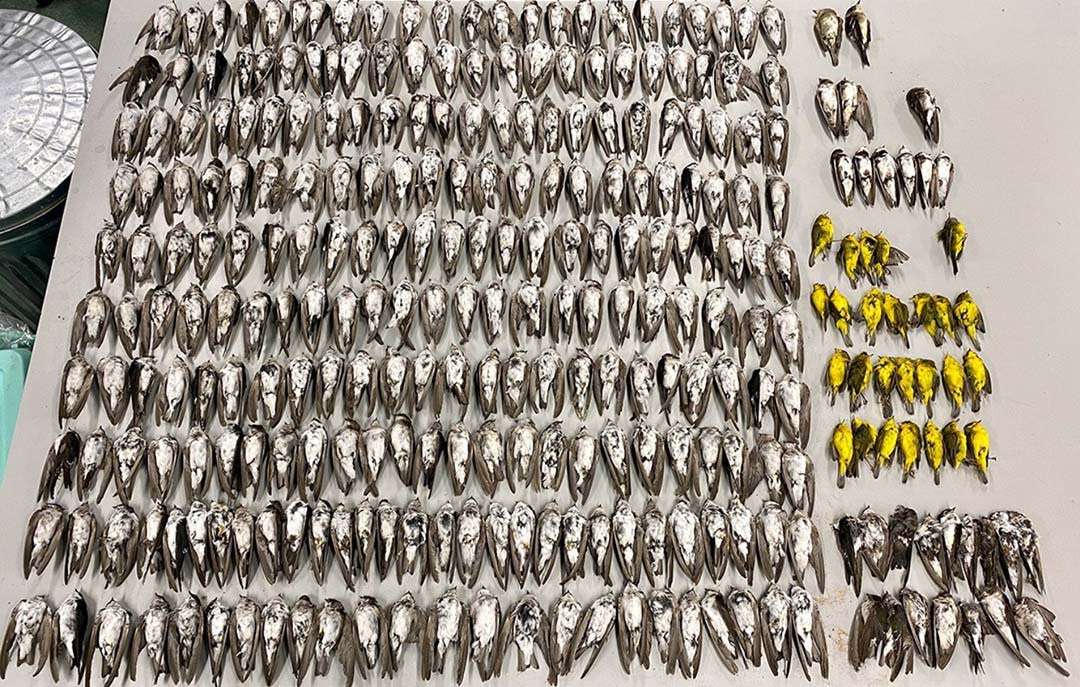
The joke in Colorado is if you don’t like the weather, wait 5 minutes …
The record-breaking Sept. 9 snowstorm of 2020 swept in overnight, just days after the Denver area hit record temperatures of 101 degrees. The National Weather Service reported that the storm, with near hurricane-force winds and temperatures that plummeted into the 30s, dumped snow all the way from Montana to New Mexico.
It happened to be the night where hundreds of thousands of birds, yellow warblers, black-throated blue warblers, thrushes, swallows and sparrows, were in flight over Colorado, migrating on their journey south.
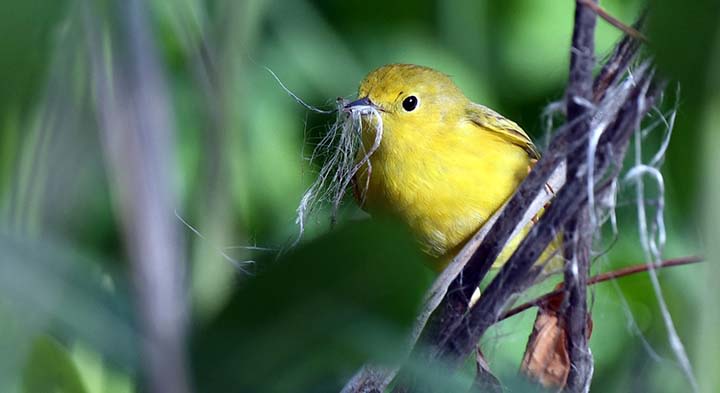
This Yellow Warbler is gathering fibers to build a nest. The species is experiencing population declines due to climate change. (Photo courtesy Chuck Hundertmark)
This Yellow Warbler is gathering fibers to build a nest. The species is experiencing population declines due to climate change. (Photo courtesy Chuck Hundertmark)
When the weather is bad during night migration south, the birds fly down into micro-habitats in cities or along rivers, in search of food, to escape the dangerous winds or snow.
The Yellow Warbler in full song. (Video provided by Jackson Childs, YouTube)
Zach Hutchinson, a community naturalist and science coordinator with the Northern Colorado Audubon society, went out the next day, to check on the birds.
“When I went out after the storm, there were 600 warblers on a stretch of the North Platte River. Instead of feeding in trees, they were all sitting on algae mats on the water. They were doing that because when the insects all die, they fell in and around the river and got washed down river and got caught in the algae mats,” Hutchinson said. “They were sitting on the algae mats eating dead insects.”
“It’s where they were able to find food, so they were doing the best that they could under the circumstances. There were also swallows flying over the mats to get food,” Hutchinson said.
In the week or so after the extreme September snow storm, people began finding dead birds all over the state: Durango, Gunnison, the San Luis Valley and Vail, as well as many locations in New Mexico, ranging from hiking trails to suburban driveways and golf courses, according to the Daily Sentinel. There were also incidents of birds acting strangely, some on the ground and many sitting on roads, getting run over, according to CNN. Some birds fell out of the sky, dead, according to Colorado Public radio.

A bird die-off found near Vail, Colorado in September. (Photo provided by iNaturalist)
A bird die-off found near Vail, Colorado in September. (Photo provided by iNaturalist)
Kyle Horton, assistant professor in Fish Wildlife and Conservation Biology at Colorado State University, went out after the early September snowstorm near Fort Collins and observed strange bird behavior. He said that birds generally migrate at night and that’s when the storm hit the flying birds the hardest. He saw the stress on the birds firsthand.
“It’s certainly odd to see birds trying to flit around for insects,” he said. “I saw lots of Warblers moving around very rapidly, more quickly in terms of what I would normally expect during a stopover in migration, in that it seemed like they were just looking for food.
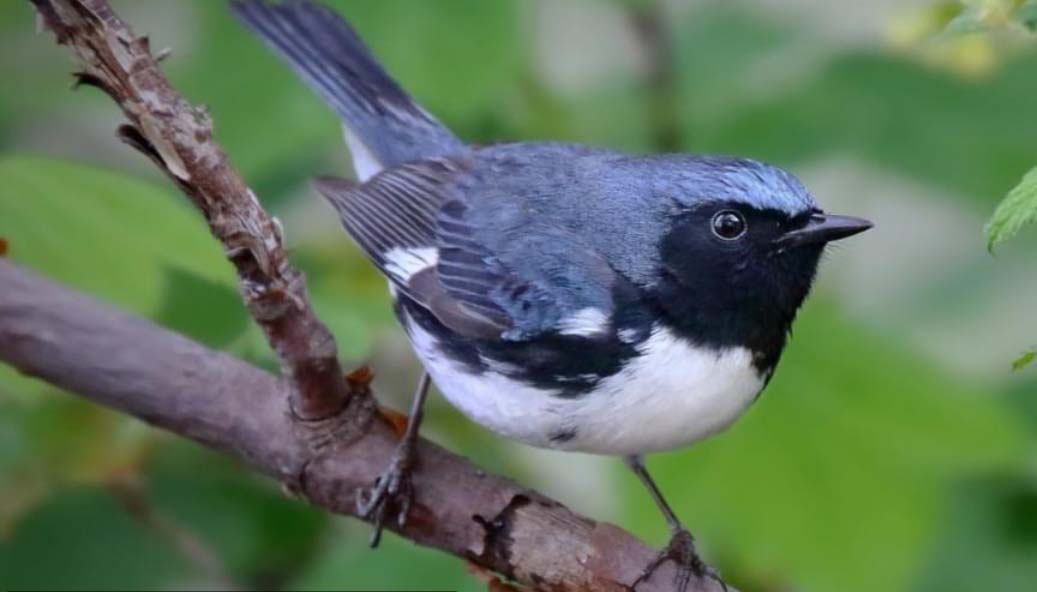
The Black-throated Blue Warbler. It's now a rare site in Colorado, due to declining populations due to climate change. (Photo provided by Tim Hopwood, Cornell Ornithology Lab)
The Black-throated Blue Warbler. It's now a rare site in Colorado, due to declining populations due to climate change. (Photo provided by Tim Hopwood, Cornell Ornithology Lab)
“If you think 2020 is a tough year for people, try being a migratory songbird. These small birds that move back and forth annually between North and South America have been hit by several environmental factors that have formed a bird’s worst-case-scenario. Drought has made for a tough summer. Follow that with a freak early winter storm system that prompted migration before many birds were physically ready and it’s bad enough. Throw in the heavy smoke from wildfires and it is more than many of these birds can handle,” said Randy Hampton, public information officer with Colorado Parks and Wildlife’s Northeast Region in a CBS 4 news report.
The Black-throated Blue Warbler in full song. (Video provided by YouTube)
Why is this happening?
3 Billion birds lost since 1970
Migratory birds were already in trouble. North America has lost more than 3 billion birds, nearly 30% of the total, since 1970, according to a study published in Science magazine, conducted by U.S. and Canadian scientists in eight organizations, including the Bird Conservancy of the Rockies, in a collaborative 2019 study of bird population declines.
Horton says the 3 billion bird loss study showed that the steepest decline of migratory birds happened in the 1970s and 80s and have tapered off since then.
“When we try to pick out anything by itself, we find it hitched to everything else in the universe.”
“We certainly have lost a lot of birds,” said Horton, “I think birds are doing better now than they were 40 or 50 years ago, but there’s still declines happening and some birds are declining more rapidly.”
Climate change
A domino effect of climate change factors, droughts caused by record-breaking hot summer temperatures, which led to an unprecedented 2020 fire season and then to the abrupt early September snow storm, has caused alarm among biologists and lovers of birds.
"The anthropologist Richard Leakey has warned that 'Homo sapiens might not only be the agent of the sixth extinction, but also risks being one of its victims.' A sign in the Hall of Biodiversity offers a quote from the Stanford ecologist Paul Ehrlich:
" 'IN PUSHING OTHER SPECIES TO EXTINCTION, HUMANITY IS BUSY SAWING OFF THE LIMB ON WHICH IT PERCHES.' ”
“There’s a preponderance of evidence growing that aerial insectivores, these birds and bats that eat insects for their primary prey, are largely declining across North America,” Horton said.
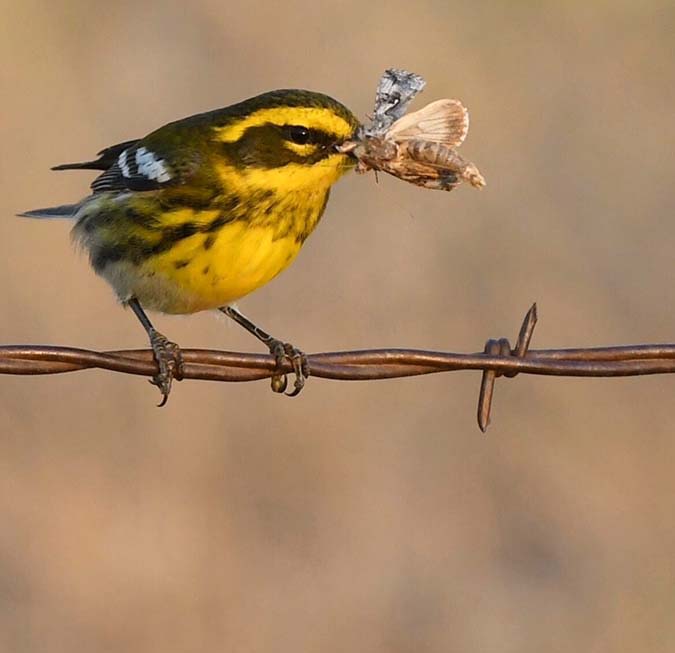
The Yellow Pine Warbler, another decling species that eats insects. (Photo provided by Cornell Ornithology Lab)
The Yellow Pine Warbler, another decling species that eats insects. (Photo provided by Cornell Ornithology Lab)
“I think climate change is certainly a thread here,” Horton said. “There’s no question among scientists that the drought is inflicted through climate change that wildfire severity is inflicted through climate change. That’s not to say that wildfires and drought are not decoupled, they’re complementary.”
“It is estimated that one-third of all
reef-building corals, a third of all freshwater mollusks, a third of sharks and rays, a quarter of all mammals, a fifth
of all reptiles, and a sixth of all birds are headed toward oblivion.”
Horton is leading a research group, with $1 million in funds from the National Science Foundation to use radar data in different areas in Colorado, including wildfire areas, to learn more about what’s causing the loss of insect-eating migratory birds. The group will study migratory behavior of the Mexican free-tailed bats, tree swallows and purple martins over the next three years to determine the reasons for population declines.
The University of New Mexico, Colorado State University and other organizations across the United States, are also looking at other possible factors, such as the September snow storm in the Mountain West and the drought in the Southwest that has depleted the insect populations that are a source of food for many migratory birds.
“The climate change thread is real. Anomalous weather is obviously becoming more common under climate change scenarios,” said Horton.
Hutchinson cited studies where scientists use counts from volunteers, Christmas bird counts, a yearly census of birds, that have shown these stunning declines, particularly with insect-eating songbirds. They also use radar to track flocks of migrating birds to calculate populations. It has showed that these declines are not just rare and threatened species, but even common birds such as sparrows and blackbirds.
“We are in the midst of the sixth mass extinction. The extinction rate is up to ten thousand times faster than what is considered normal – with up to 200 species becoming extinct every single day."
“Likely, there won’t be one single answer. A lot of birds are being found dead right now,” said Hutchinson. “There’s probably a multitude of reasons across the various species for these die-offs.”
Droughts that cause wildfires
Since 2000, with the exception of a few months, Colorado has been in a continuous drought, some areas worse than others, according to the U.S. Drought Monitor. Colorado and other areas in the western United States are also experiencing the more extreme flash droughts. That’s when drought conditions in an area worsen by a category or two within two-month period. There are five categories of drought, D-0, abnormally dry to D-4, exceptional drought.
Most areas in Colorado in the last six months, have seen droughts in this flash category with warmer than average summer temperatures, according to the Climate Prediction Center. Areas in the eastern plains have experienced a three or four category increase, according to the U.S. Drought Monitor.
The U.S. National Climate Assessment uses NASA satellite data to track climate change. Their research clearly shows that humans have been influencing global patterns of drought for nearly a century. Warming temperatures and changing precipitation patterns have lead to these droughts, according NASA research.
As average global temperatures have risen, the heat has contributed to drier conditions, according to drought.gov. Western states, including Colorado have lived through fires that have grown bigger, more destructive and costlier in lives, property loss and increasing stress on migratory birds and many other animal species.
The wildfires
Wildlife biologists are examining whether the wildfires in the west, may be a factor in the bird deaths, with smoke plumes and particulates potentially altering migration routes or increasing the toxins inhaled by birds.

The Cameron Peak Fire in August, 2020 near Estes Park. Fires are another climate change domino that can cause population declines in bird species due to permanent habitat loss. Birds inhale patriculates and toxins. Fires also cause birds to migrate too early, when they don't have proper fat stores. (Photo provided by 9News)
The Cameron Peak Fire in August, 2020 near Estes Park. Fires are another climate change domino that can cause population declines in bird species due to permanent habitat loss. Birds inhale patriculates and toxins. Fires also cause birds to migrate too early, when they don't have proper fat stores. (Photo provided by 9News)
“Fire is a natural part of the landscape. The problem we are experiencing is that climate change is forcing droughts and more frequent and intense fires,” said Hutchinson. “Fires this frequent and at this level of intensity are what create a big problems.”
“If this becomes the norm and not the exception, we need to be aware of that. We need to be alarmed if that’s what’s happening,” said Hutchinson. “If these natural disasters increase in frequency and intensity, that’s a concern for migratory species.”
The unprecedented size and numbers of wildfires all across the West, have also caused the birds to migrate early before they built up their fat stores, according to Hutchinson, putting further stress on migratory songbirds.
“What climate change is doing to the frequency and intensity of fires, that’s a game-changer,” Hutchinson said. “If it becomes more intense, where the fires don’t leave that patchwork mosaic of habitat, it can create new problems.”
“You’re getting rid of a habitat that a very certain set of bird species depends upon and you’re ruining their habitat. (Fires) are creating habitat for other bird species, but then the birds that depended on that are slowly going to be losing more habitat,” said Hutchinson.
Some species of birds like woodpeckers benefit in the aftermath of fires, Hutchinson added, but studies are showing that many forests may never come back from wildfires.
Hotter than average temperatures
Hutchinson said that the record-setting hotter than average temperatures can decrease a bird’s ability to build up fat stores and reproduce. Too much heat slows down the bird’s productivity. The birds are less active and produce less offspring, further dwindling bird populations.
“Just having this decrease in productivity, you could quickly see a downward spiral effect from that,” Hutchinson said.
“If the average temperatures continue to increase at the rate it’s going or that rate increases, then the picture looks grim for birds and other wildlife,” Hutchinson said.
Habitat loss
“The way climate change is most likely going to affect birds is the impacts on habitat,” said Chuck Hundertmark, a longtime bird watcher and past president of Denver Field Ornithologists. “Birds that are dependent on mountain forests, the endangered Rosy Finch, for example, are going to be impacted as these forests change (with wildfire burns and human encroachment)
“Climate change is another human induced factor significantly altering habitat,” Hundertmark said. “The rate at which that change is happening and going to happen is going to be a major factor in determining how bird species can adapt to the change. I think in the long term, it’s going to drive the loss of diversity.”
“The grown-ups have failed us. And since most of them including the press and politicians keep ignoring the situation we must take action into our own hands. Starting today. Everyone is welcome. Everyone is needed.”
Bird food: insect populations
Hundertmark says he’s also seen a big decrease in insect populations, food for most migratory bird species.
“I noticed the ‘windshield evidence’, which is when you’re driving down the highway or interstate or county roads, the amount of insects that hit the windshield just seems to be a lot less of a problem than it used to be,” Hundertmark said. “There’s been more and more articles about what’s happening to insects? Is that a function of habitat change, pesticides, insecticides? What’s driving that change?”
Bird watcher numbers on the increase
Hundertmark said that because of the pandemic, the number of bird watchers continues to grow, because it’s an activity you can do by yourself or with less people. The skills of birders are improving, because there’s so many new tools. Denver Field Ornithologists(DFO), are seeing more posts on their Facebook page from members and backyard bird enthusiasts, posting pictures of birds they’ve seen in their backyards and out on the birding trails, asking experienced DFO members what bird they’re seeing and getting excited about different bird species.
“I go to birds selfishly, but I also go to them because they are one of the few things that are capable of prying me out of myself. They don’t do this always or even often and when they do it it’s not for very long. But they do it. They give me transport along with contact. For that, and the fact that they fly, I love them. I don’t like the geeky aspect of learning their names and calls as much as I like the sheer simplicity and transcendence of their lives.”
Hundertmark has been an avid bird watcher for over 50 years. He goes out on a regular basis, birding to places like Barr Lake State Park near Brighton, Walden Ponds just outside of Boulder and many small lakes and trails through the suburban areas in and around the Denver-Boulder corridor.
He says bird watching has gotten so much easier with technology.
“If I’m out in the field birding and I want to find out if there’s any unusual birds around, I can just look on my phone and check on eBird.org and it will tell me if there’s a rare bird in my area where I’m birding,” Hundertmark said. “It gets easier and easier.”
Bird species endangered or threatened
in Colorado
Hutchinson said Colorado has seen a significant loss of around 70% of Evening Grosbeaks. The Audubon Society has seen big declines in its Christmas bird counts of the species and theorizes that due to warmer temperatures, they may not be migrating as far south, while also losing food sources due to habitat loss.
An endangered Evening Grosbeak male singing a love song. (Video provided by YouTube)
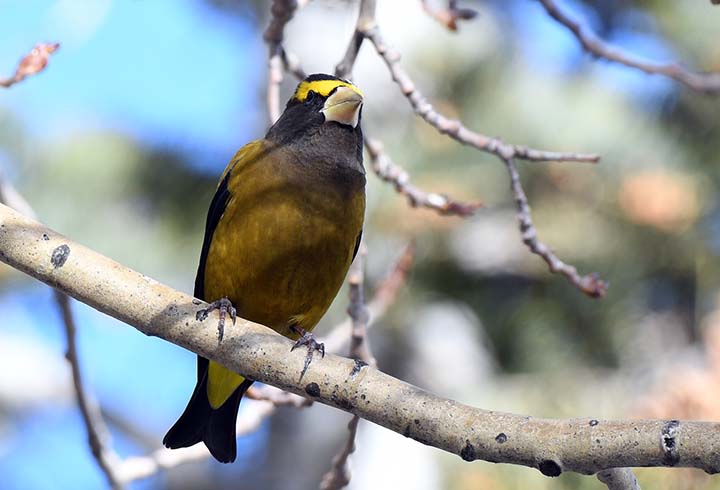
The endangered Evening Grosbeak. (Photo courtesy of Chuck Hundertmark)
The endangered Evening Grosbeak. (Photo courtesy of Chuck Hundertmark)
Grassland birds are the most endangered and threatened species in Colorado, including the Greater Sage grouse and Gunnison Sage grouse on the western slope. This category of birds have seen the steepest declines since the 1970s, because of habitat loss due to human encroachment, farming and limited water resources, according to Hutchinson.
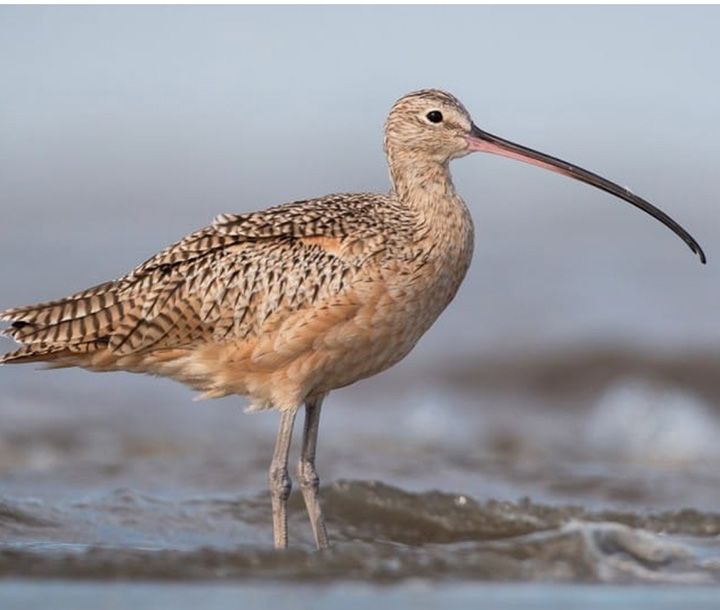
The threatened Long-billed Curlew. Threatened status means that this bird species has become endangered and has such a significant loss of habitat that they may not be able to come back. (Photo provided by Cornell Ornithology Lab)
The threatened Long-billed Curlew. Threatened status means that this bird species has become endangered and has such a significant loss of habitat that they may not be able to come back. (Photo provided by Cornell Ornithology Lab)
The Greater Sage Grouse male strutting his stuff. (Video provided by YouTube)
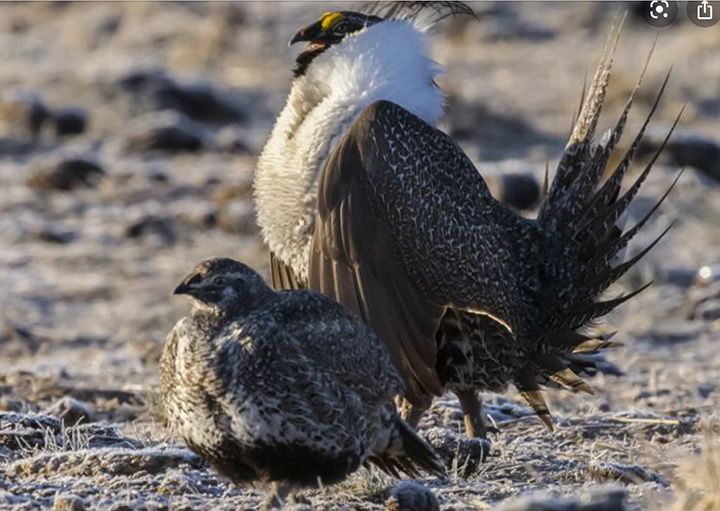
The endangered Greater Sage Grouse male and female.. Endangered species are a more serious category than threatened. The species is in danger of becoming extinct. (Photo provided by the U.S. Forest Service)
The endangered Greater Sage Grouse male and female.. Endangered species are a more serious category than threatened. The species is in danger of becoming extinct. (Photo provided by the U.S. Forest Service)
Hundertmark agrees that shortgrass prairie species, like Curlews and Mountain Plovers, are showing the steepest declines throughout the western states, due to habitat loss for farming, particularly in eastern Colorado.
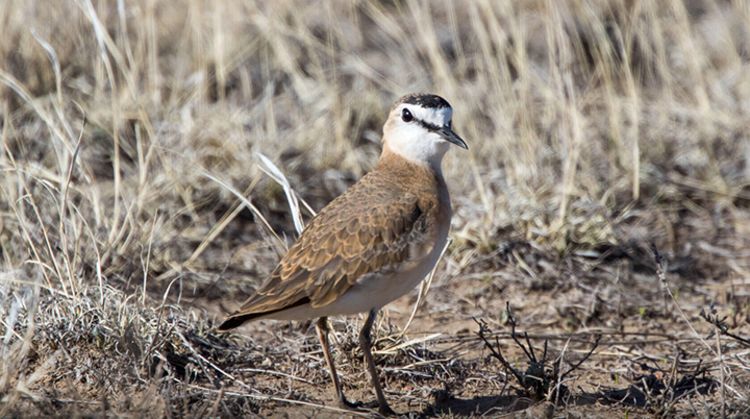
The Mountain Plover., another species that's on the brink of extinction. The U.S. Environmental Protection Agency keeps lists of Threatened and Endangered species. (Photo provided by the Audubon Society)
The Mountain Plover., another species that's on the brink of extinction. The U.S. Environmental Protection Agency keeps lists of Threatened and Endangered species. (Photo provided by the Audubon Society)
“Long-billed curlews and Mountain plovers are harder to find. You really have to know where to go to find them now. Whereas, twenty or thirty years ago, you could find them much more regularly. That’s a trend with all our grassland birds.”
Hundertmark said he has seen certain other migratory birds species, like the Black Phoebe moving slowly northward from New Mexico, into Canon city and ever northward because of the warmer temperatures.
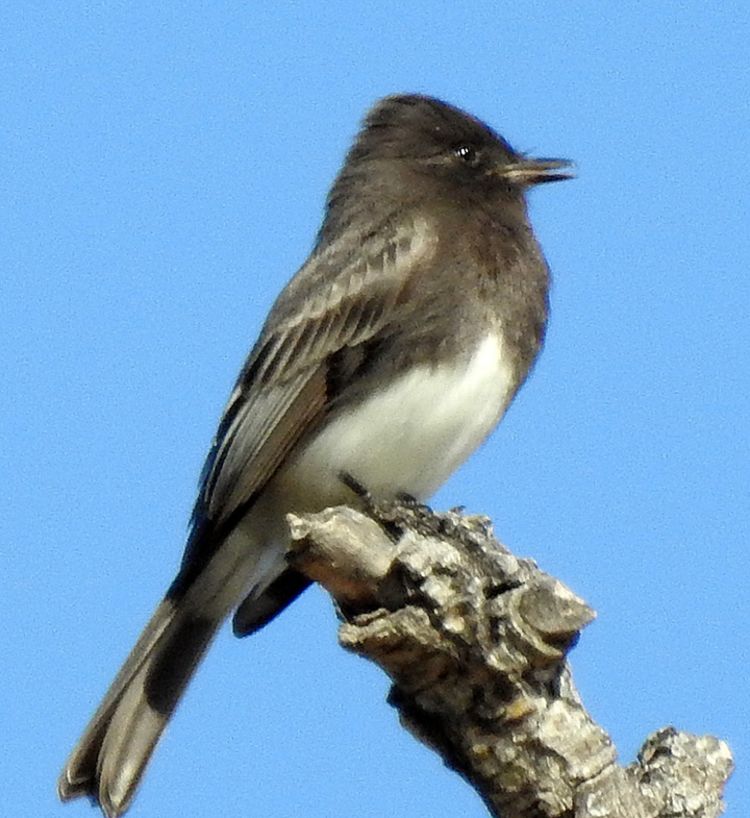
The Black Phoebe. This species is moving more North as the climate changes and temperatures are warming. (Photo courtesy Chuck Hundertmark)
The Black Phoebe. This species is moving more North as the climate changes and temperatures are warming. (Photo courtesy Chuck Hundertmark)
“They are showing up in Boulder and Larimer counties. These would have been outstanding occurrences twenty or thirty years ago. That’s quite possibly a function of climate change,” Hundertmark said.
He’s also seeing the Eastern Phoebe spreading west to Colorado far from the east coast, where it was commonly found.

The Eastern Phoebe. This species is moving from east to places west in Colorado as the climate changes to warmer temperatures. (Photo courtesy Chuck Hundertmark)
The Eastern Phoebe. This species is moving from east to places west in Colorado as the climate changes to warmer temperatures. (Photo courtesy Chuck Hundertmark)
“We have seen Eastern Phoebes moving in, Black Phoebes moving north from New Mexico areas. They interact and breed and hybridize, creating interesting biological situations,” Hundertmark said.
Rosy finches are another species in Colorado that is endangered, according to Hundertmark. Christmas bird counts indicate that Rosy finches are on the decline. Their breeding range is limited to Colorado and a small portion of New Mexico. The finches are specialists that feed on insects that get trapped in glacial mountain snow. Climate change is shrinking mountain glaciers, according to a groundbreaking 2016 Nature Geoscience paper.
Rosy Finches flock to a feeder in Silverthorne in December, 2019 after a snowstorm looking for food. (Video provided by YouTube)
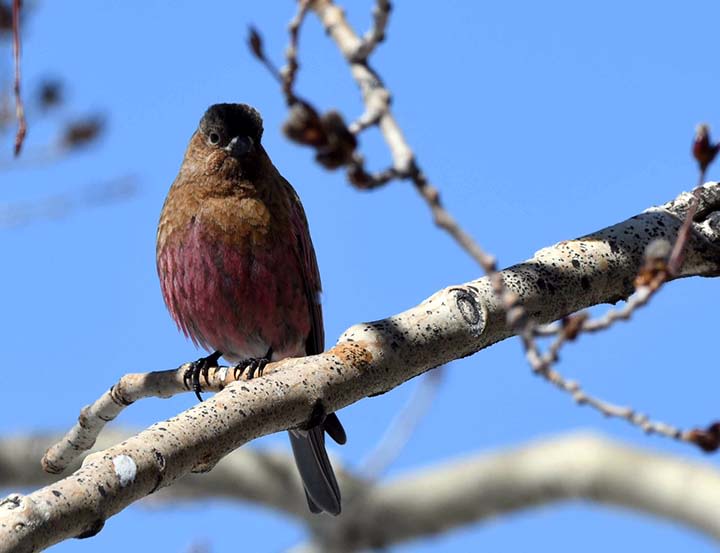
The endangered Rosy Finch. (Photo courtesy Chuck Hundertmark)
The endangered Rosy Finch. (Photo courtesy Chuck Hundertmark)
“As we have less and less of that glacial snow remaining in the mountains. What’s the impact going to be on Rosy Finches? We don’t know yet,” said Hundertmark.
“The three species of Rosy finches have become areas of conservation concern among biologists,” Hundertmark said. “Climate change is the big source of concern about them. They all have relatively restricted ranges and specialized habitat needs.”
Horton added that another devastating impact on bird populations are domestic and feral cats on the prowl, killing more than a billion birds a year. He strongly encourages keeping pet cats indoors.
Theories on migratory bird die-offs
Bird die-offs are still being reported months later, throughout the southwestern United States, according to iNaturalist, an AP created by a joint initiative between the California Academy of Sciences and National Geographic. It has received thousands of similar observations from citizen bird watchers all across the southwest.
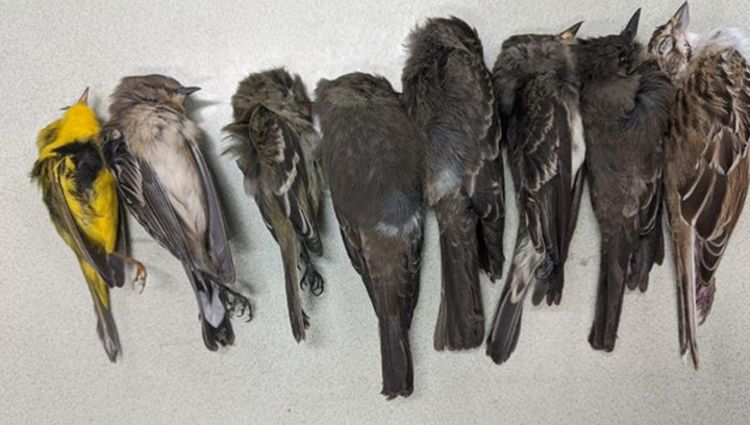
Hundreds of thousands of birds have been found dead in Colorado and New Mexico in 2020. These are warblers and sparrows that were found in September 2020. (Photo provided by Allison Salas, University of New Mexico)
Hundreds of thousands of birds have been found dead in Colorado and New Mexico in 2020. These are warblers and sparrows that were found in September 2020. (Photo provided by Allison Salas, University of New Mexico)
New Mexico State University (NMSU) research biologist, Martha Desmond, is leading a team of scientists to uncover the unknown forces behind these massive bird die-offs, warns that these massive bird die-offs are an "alarm," according to a recent Las Cruces Sun News article.
“Climate change is only going to cause more abnormal storms like this,” said Hutchinson. “When storms come that early in the year and are so severe and intense, that creates a lot of stress on birds.”
“The majority of the birds that were affected, were birds that almost exclusively feed on insects,” said Hutchinson. “What a storm like that does is it kills off insects to where the flying feeders can’t feed upon them.”
“The leading theory as to what happened was that the bird mortality events I’ve seen are caused by starvation and hypothermia,” Hutchinson said. “Right now what we do have some inclination on, is that the birds were all severely underweight.”
“The cold snap had a pretty detrimental impact on the birds and their survival, but birds were dying before that happened,” said Horton. “We know that cold weather impacted the birds. That’s very clear. But, it’s one of these things that it was additive to what was happening already. It makes the cold snap even worse. It magnifies the impact on something that otherwise would kill birds regardless, but maybe not as many birds.”
Colorado Parks and Wildlife says its veterinary team has been analyzing carcasses, warblers, bluebirds and pewees from the recent deaths. Their bodies are in very poor condition, suggesting starvation and exposure.
Many of the bird die-off specimens were sent off to labs to be further analyzed by biologists.
“We’re hoping to learn from these events and then try to forecast what might happen next year or the years to come, so we can be ready for the next event,” Horton said.
The politics of science
“We nature lovers are hypocrites, of course,” Dan Driscoll said. “We are all hypocrites. None of us are consistent. The problem is that we let that fact stop us. We worry that if we fight for nature, people will say, ‘But you drive a car,’ or, ‘You fly a lot,’ or, ‘You’re a consumer, too.’ And that stops us in our tracks. It’s almost as if admitting that they are hypocrites let’s people off the hook.” We need more hypocrites.
Hundertmark says another challenge is the lag time between climate change impacts we’re in the midst of now and undertaking scientific studies that can take years, decades to complete, for example, the 3 billion birds study that was just completed in 2019.
“Science can’t give us the answer, until they know what the question is,” Hundertmark said. “Science can’t solve the problem. It can give us answers eventually. Most of the solutions have to be political and economic now. Therein lies the challenge.”
What You can do to help
Chuck Hundertmark, avid birder for more than 50 years and past President of Denver Field Ornithologists recommends:
1. Become a bird watcher!
2. Consider your home landscaping:
a. Plant bird friendly trees and shrubs, particularly fruit trees
b. Plant flowering plants that produce nectar for hummingbirds
3. Provide a year round water source, particularly during these fires, bird baths and a heated bird bath for winter.
4. Vote to support policies that are habitat and bird friendly that includes sound forest management
5. Recognize that climate change is real, that we are in the midst of its impacts. Talk about and support policies that reduces our dependence on fossil fuels as quickly as possible. “That’s the biggest impact we can have.”
Zach Hutchinson at the Audubon Society has outlined five key steps:
1. Reduce your use of energy at home and ask your elected officials to support energy-saving policies that reduce the overall demand for electricity and that save consumers money.
2. Ask your elected officials to expand responsibly-sited, consumer-driven clean energy development that grows jobs in your community–like solar or wind power.
3. Reduce the amount of carbon pollution released into the atmosphere. In order to drive down carbon emissions, we will need innovative economy-wide solutions that address every sector of the economy–like a fee on carbon. Another option is to address carbon emissions one sector at a time like setting a clean energy standard for electricity generation.
4. Advocate for natural solutions, from increasing wetlands along rivers that absorb soaking rains to protecting forests and grasslands that are homes to birds and serve as carbon storage banks, and putting native plants everywhere to help birds adapt to climate change.
5. Ask elected leaders to be climate and conservation champions.
To learn how birds will be affected in Colorado and how you can help, visit the
Kyle Horton, Assistant Professor in Fish, Wildlife and Conservation Biology at Colorado Sate University recommends:
1. Keep your cats indoors. They live a longer, safer life indoors. Horton says they are responsible for more than a billion bird deaths per year.
2. Migratory songbirds migrate at night. Light pollution draws migratory birds into unsafe environments and can cause collisions. Turn off your lights on key nights. Go to BirdCast.info or Aeroecolab.com to find out which nights in your city to keep lights off to save the birds from death.
3. Promote safe airspaces. About another billion birds collide with tall buildings and windows.
David Gessner, Nature author of 11 books and bird enthusiast recommends:
“I suppose it would be asking too much of this little book, My Green Manifesto: Down the Charles River in Pursuit of a New Environmentalism, but this is my fantasy of how one might respond to climate change.”
Three things:
1. Have a small love affair with something in the world.
2. Get in a fight over it.
3. Launch a larger project of self and world.
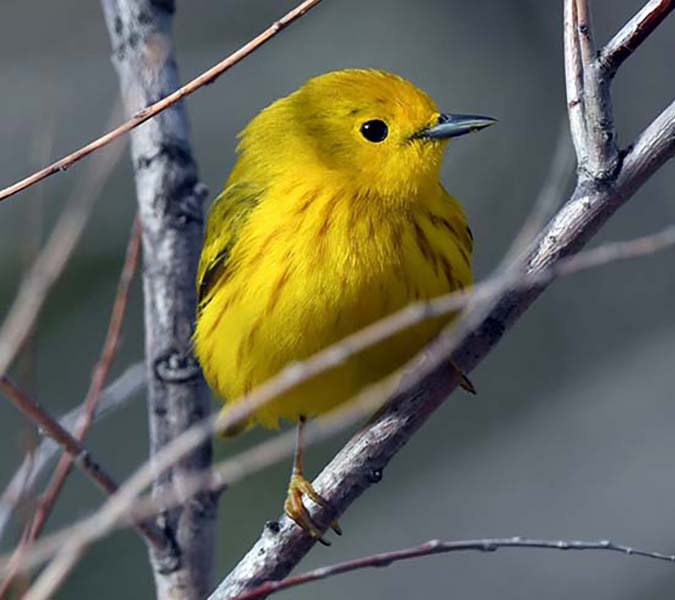
The Yellow Warbler is a declining bird species in Colorado. Their dead bodies are found in many of the recent bird die-offs. This is one of the species of songbirds that is not only beautiful, but they play a key role in food webs and ecosystem functions from seed dispersal to pest control. (Photo courtesy Chuck Hundertmark)
The Yellow Warbler is a declining bird species in Colorado. Their dead bodies are found in many of the recent bird die-offs. This is one of the species of songbirds that is not only beautiful, but they play a key role in food webs and ecosystem functions from seed dispersal to pest control. (Photo courtesy Chuck Hundertmark)
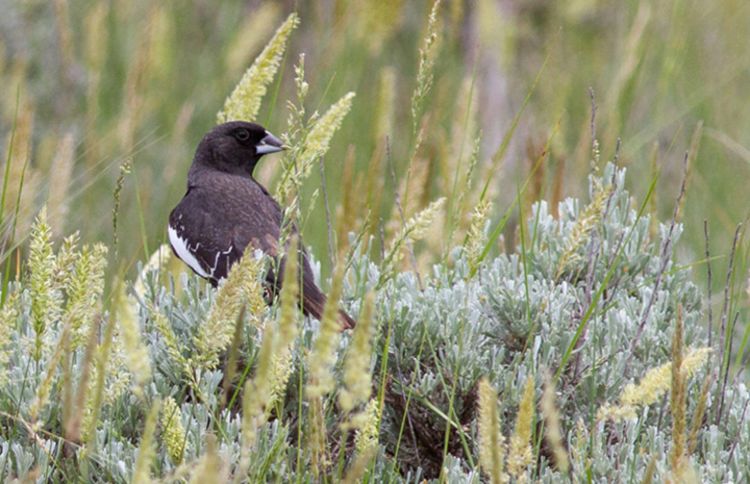
Have you seen this bird? Even the Lark Bunting, Colorado's State bird is threatened with extinction from climate change, according to the Audubon Society. Two-thirds of America's birds are threatened with extinction, but keeping global temperatures down could save 76% of them. (Photo provided by the Audubon Society)
Have you seen this bird? Even the Lark Bunting, Colorado's State bird is threatened with extinction from climate change, according to the Audubon Society. Two-thirds of America's birds are threatened with extinction, but keeping global temperatures down could save 76% of them. (Photo provided by the Audubon Society)
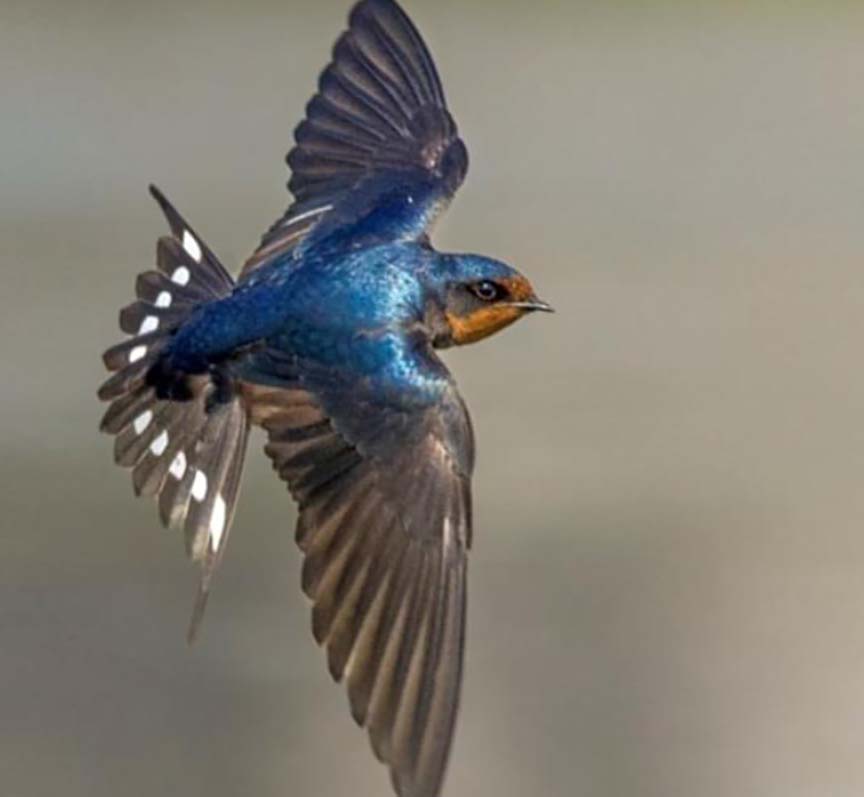
This is a Barn swallow. Swallow populations are also declining. They are key in the ecosystem and keep insect populations under control. (Photo provided by Cornell Ornithology Lab)
This is a Barn swallow. Swallow populations are also declining. They are key in the ecosystem and keep insect populations under control. (Photo provided by Cornell Ornithology Lab)
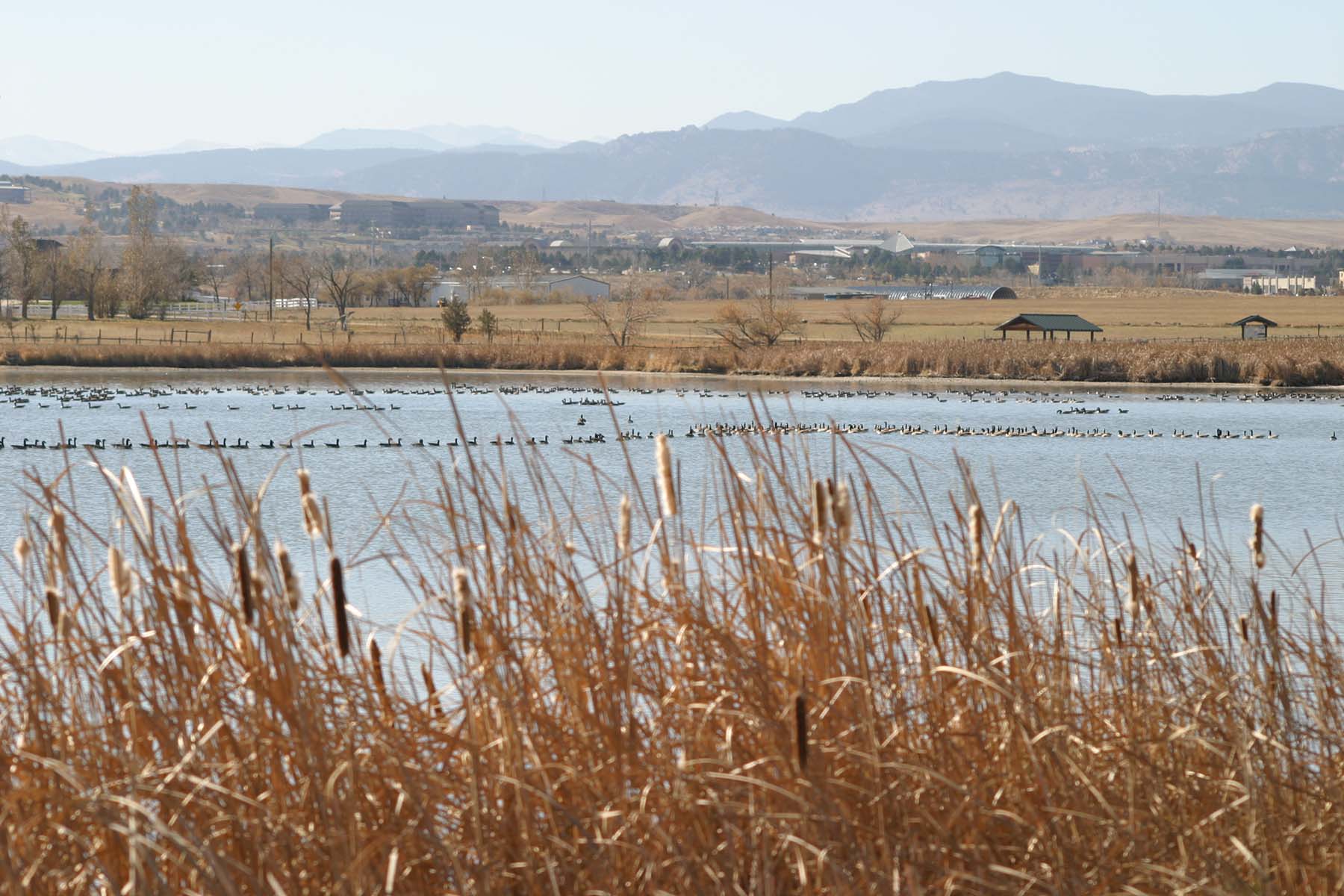
Canadian Geese and other waterfowl swimming in formation at Stearns Lake in Broomfield, Colorado in October 2020. Populations of American ducks and geese have grown by 56% since 1970, in contrast to many other insectivore bird species that are in decline, according to the Audubon society. Canadian Geese and other waterfowl species, like ducks, migrate to Colorado in the winter. (Rhonnie Crutcher, CU News Corp)
Canadian Geese and other waterfowl swimming in formation at Stearns Lake in Broomfield, Colorado in October 2020. Populations of American ducks and geese have grown by 56% since 1970, in contrast to many other insectivore bird species that are in decline, according to the Audubon society. Canadian Geese and other waterfowl species, like ducks, migrate to Colorado in the winter. (Rhonnie Crutcher, CU News Corp)
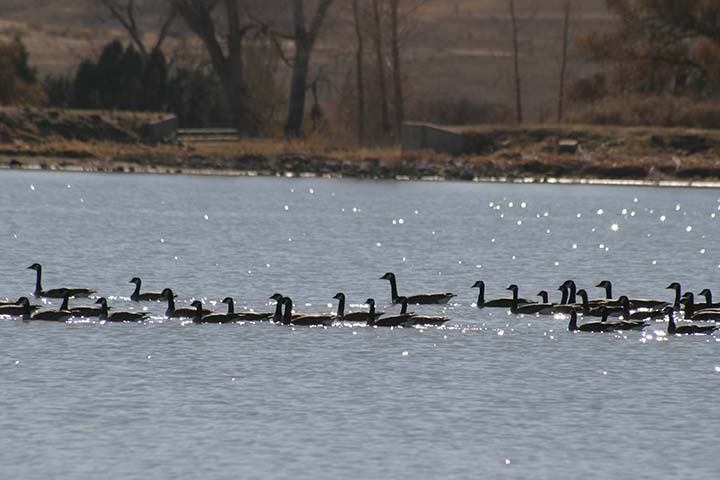
Canadian Geese jockeying for position at Stearns Lake in Broomfield in October 2020. (Rhonnie Crutcher, CU News Corp)
Canadian Geese jockeying for position at Stearns Lake in Broomfield in October 2020. (Rhonnie Crutcher, CU News Corp)

The Black-throated Blue Warbler, another declining songbird species that is key to the ecosystem. (Tim Hopwood, Cornell Ornithology Lab)
The Black-throated Blue Warbler, another declining songbird species that is key to the ecosystem. (Tim Hopwood, Cornell Ornithology Lab)
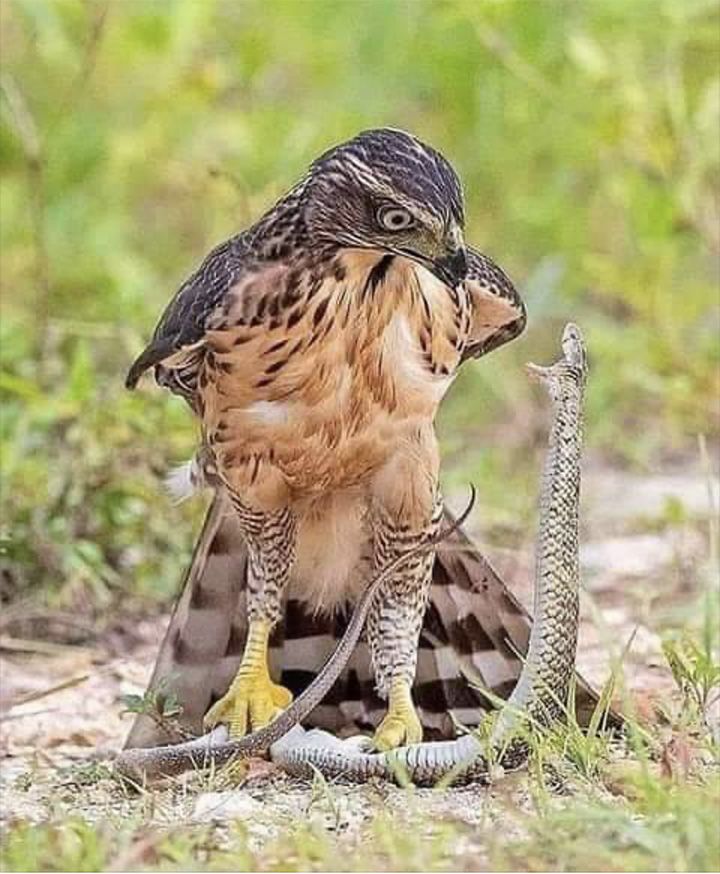
A juvenile Swainson's Hawk and the snake, his prey, at Barr Lake State Park near Brighton in September 2020. The Swainson's Hawk is listed as a threatened species, as are many hawk species. (Photo courtesy of Sandra Hoyle, Denver Field Ornithologists)
A juvenile Swainson's Hawk and the snake, his prey, at Barr Lake State Park near Brighton in September 2020. The Swainson's Hawk is listed as a threatened species, as are many hawk species. (Photo courtesy of Sandra Hoyle, Denver Field Ornithologists)
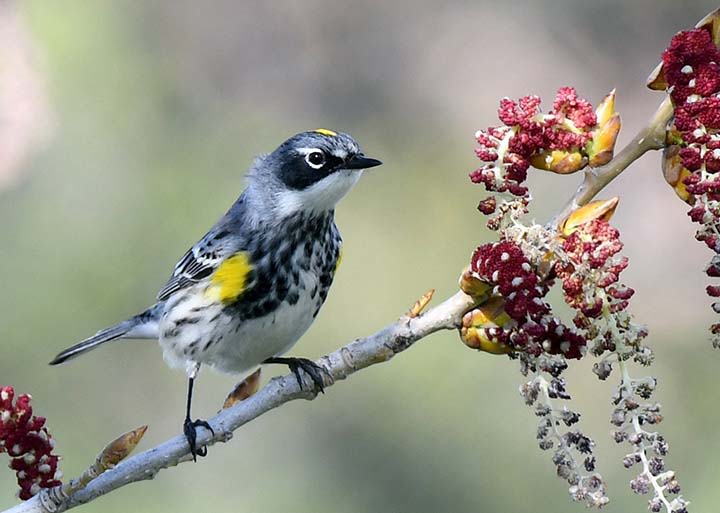
The Myrtle Warbler, another one of the declining bird species. (Photo courtesy Chuck Hundertmark)
The Myrtle Warbler, another one of the declining bird species. (Photo courtesy Chuck Hundertmark)
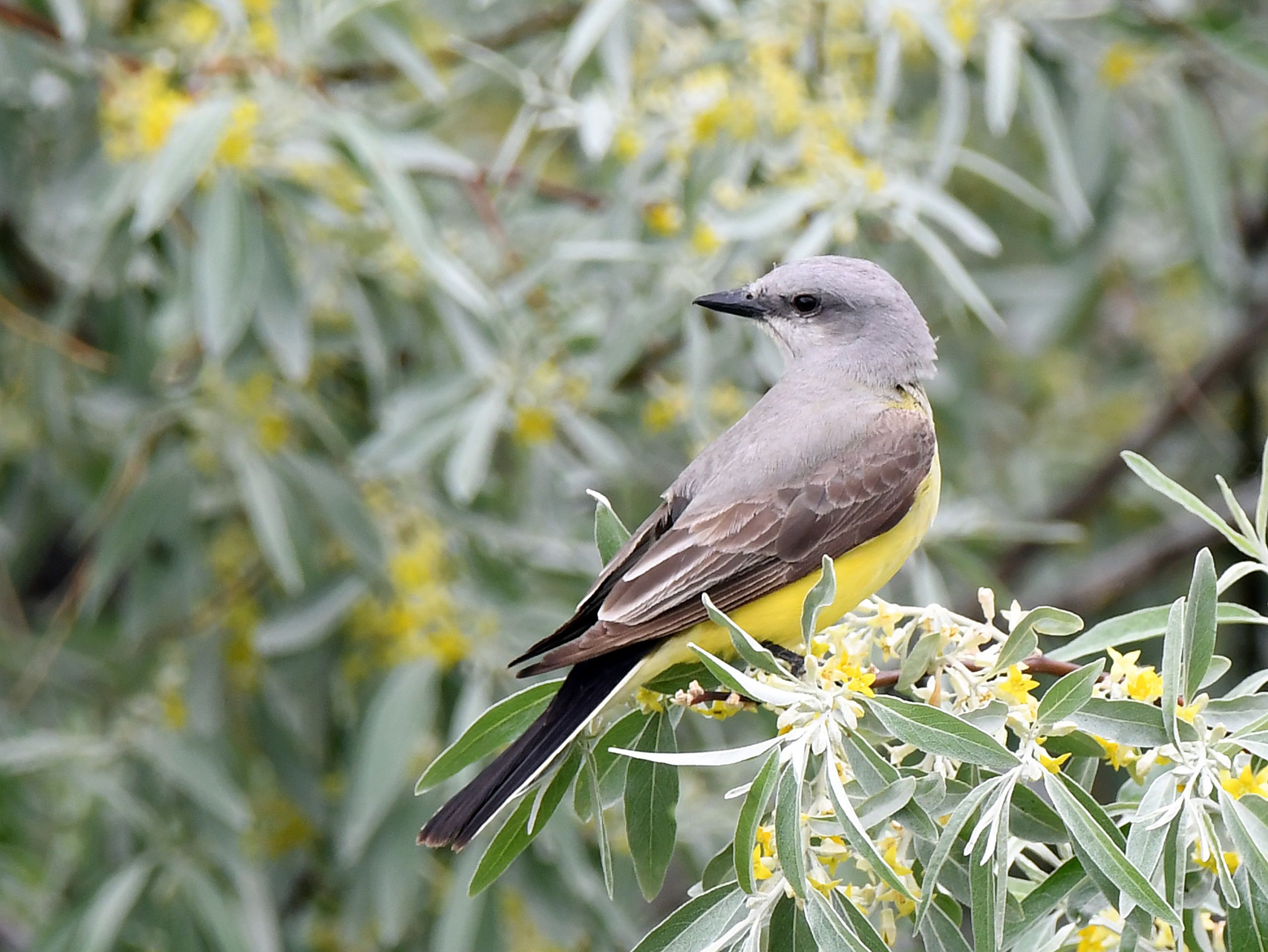
The Southwestern Willow Flycatcher. Flycatchers are another key bird species on the brink of extinction because of river flow reductions from many types of dams, including hydroelectric, according to the Environmental Protection Agency. Damming creates habitat alteration and loss for thousands of bird species. (Photo courtesy Chuck Hundertmark)
The Southwestern Willow Flycatcher. Flycatchers are another key bird species on the brink of extinction because of river flow reductions from many types of dams, including hydroelectric, according to the Environmental Protection Agency. Damming creates habitat alteration and loss for thousands of bird species. (Photo courtesy Chuck Hundertmark)
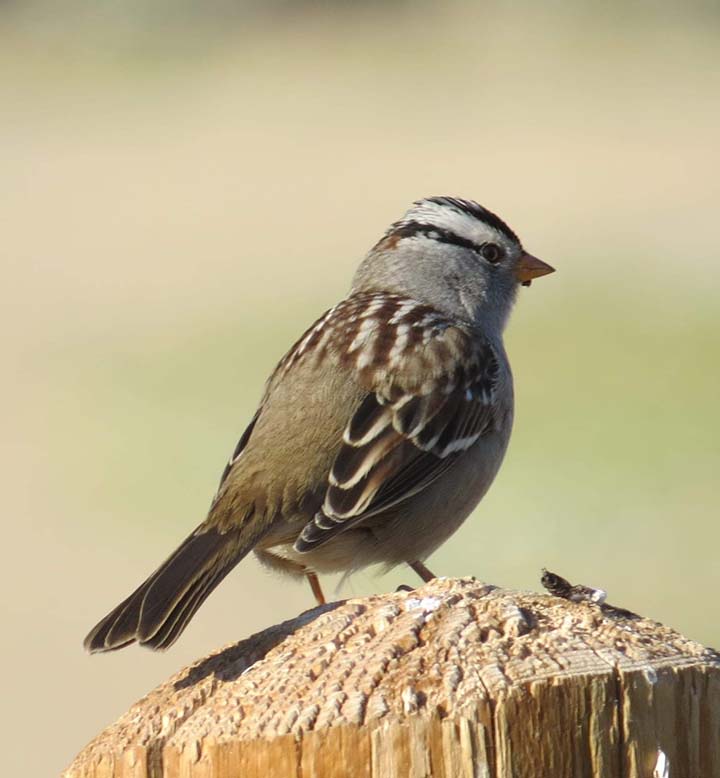
White-Crowned sparrow. It is a commonly seen sparrow species that are alsoin decline, according to Christmas bird counts done by the Audubon Society. (Photo provided by Denver Field Ornithologists)
White-Crowned sparrow. It is a commonly seen sparrow species that are alsoin decline, according to Christmas bird counts done by the Audubon Society. (Photo provided by Denver Field Ornithologists)
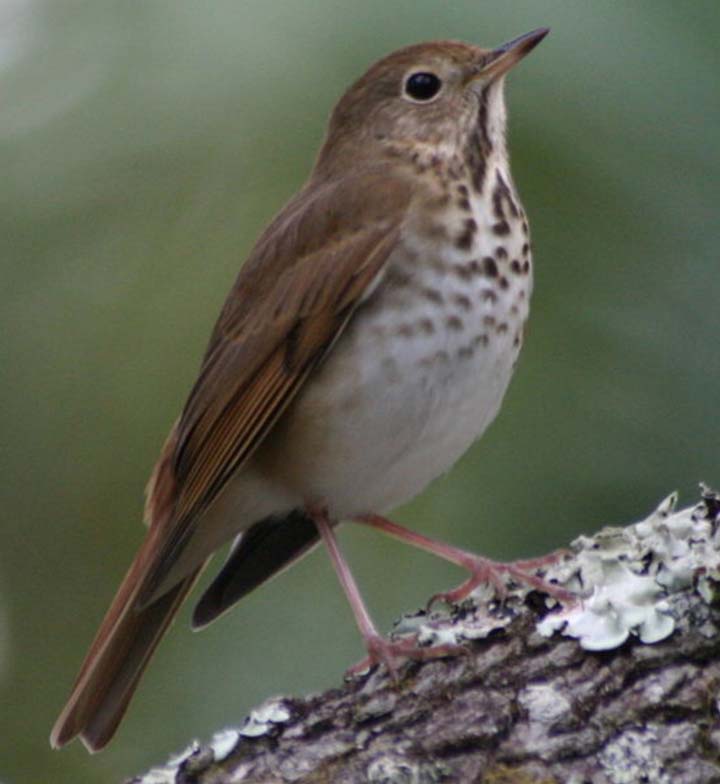
Thrushes are also on the decline. They are key species in the ecosystem. (Photo provided by Cornell Ornithology Lab)
Thrushes are also on the decline. They are key species in the ecosystem. (Photo provided by Cornell Ornithology Lab)
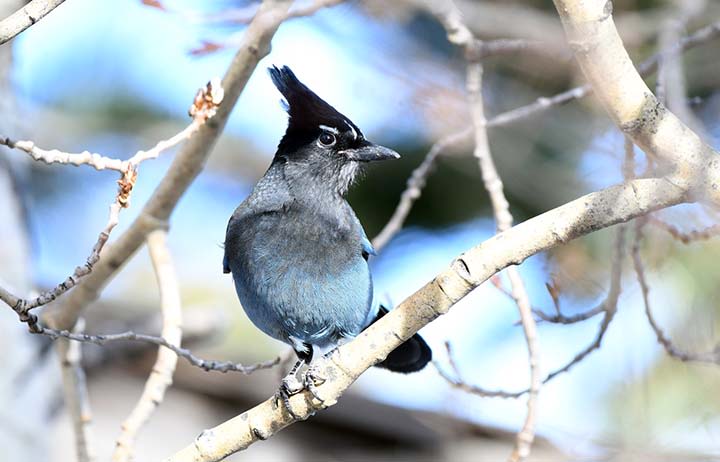
The Steller's Jay, another declining species. (Photo courtesy of Chuck Hundertmark)
The Steller's Jay, another declining species. (Photo courtesy of Chuck Hundertmark)